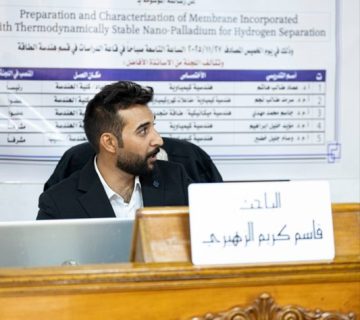The Petroleum Engineering Department at the College of Engineering, University of Baghdad, held a M.Sc. thesis examination titled:
“Comprehensive study of reservoir drilling fluid ( RDF) to solve pay-zone Damage in Horizontal wells”
By the student zaid emad mohsen and supervised by Prof. Dr. Faleh H. M. Almahdawi. The examination committee consisted of Prof. Dr.Rafid kadhim Abbas as Chairman and the membership of Assistant prof .Dr. Rwaida Kaiser Abdul Majeed and Assistant prof .Dr. Nagham j. Al-Ameri . The thesis was summarized as follows:
The objective of this study is to enhance the drilling fluid used in reservoirs in order to reduce damage. This will be achieved by comparing the performance of RDF and RDF with NPS with the traditional drilling fluid currently used in the field. The study focused on the Mishrif formation, specifically a horizontal drilling of 3000m within the reservoir. In other words, to get better properties of drilling fluids prepared with Fe2O3 NPS and ZnO NPS that can perform better performance and thermal resistance up to 400F̊.In this study laboratory tests were used and compared with field data from the southern oil field (Basra-Iraq).In both freshwater and saltwater drilling fluids, Nano particles materials ( NPS) showed the best improvement in the filtration parameters, rheological properties, and thermal stability . All of the results that obtained in this work will help to increase the stability of the produced drilling fluids overall. The effect of different concentrations of the ZnO and Fe2O3 NPs was tested on rheological, filtration properties and thermal stability of RDF. Thermal stability of the mud was tested with the temperatures reaching 400F̊. Results showed that nano-based mud possess more stable rheological behaviour at elevated temperatures compared to RDF.
Adding Fe2O3 and ZnO NPs at concentrations of 0.5, 0.75, 1, and 1.5 g /ml to RDF, The reduction in plastic viscosity (PV) was controlled by about 20% using Nanomaterials. Also, from the results, it can be seen that the rate is more constant, with a smooth decrement curve in yield point ( YP), the percentage of decreasing in (YP) at 400F̊ when adding Fe2O3 and ZnO NPs. is 8 and 12% respectively. Also, it enhances the reduction of gel strength at 10 sec and 10 min. Finally, there is no trace of thermal degradation.. The addition of nanoparticles also enhanced filtering characteristics. Fluid loss rate was reduced by 40% when adding Fe2O3 and 30% when adding ZnO NPS. The improved rate of fluid loss has a positive impact on the efficiency of drilling operations by reducing the risk of formation damage caused by filtrate invasion. The smooth, efficient surface of the mud cakes was enhanced by the inclusion of ZnO and Fe2O3 NPs, which also decreased differential sticking. Overall, when compared to RDF with NPS and RDF without NPS.








